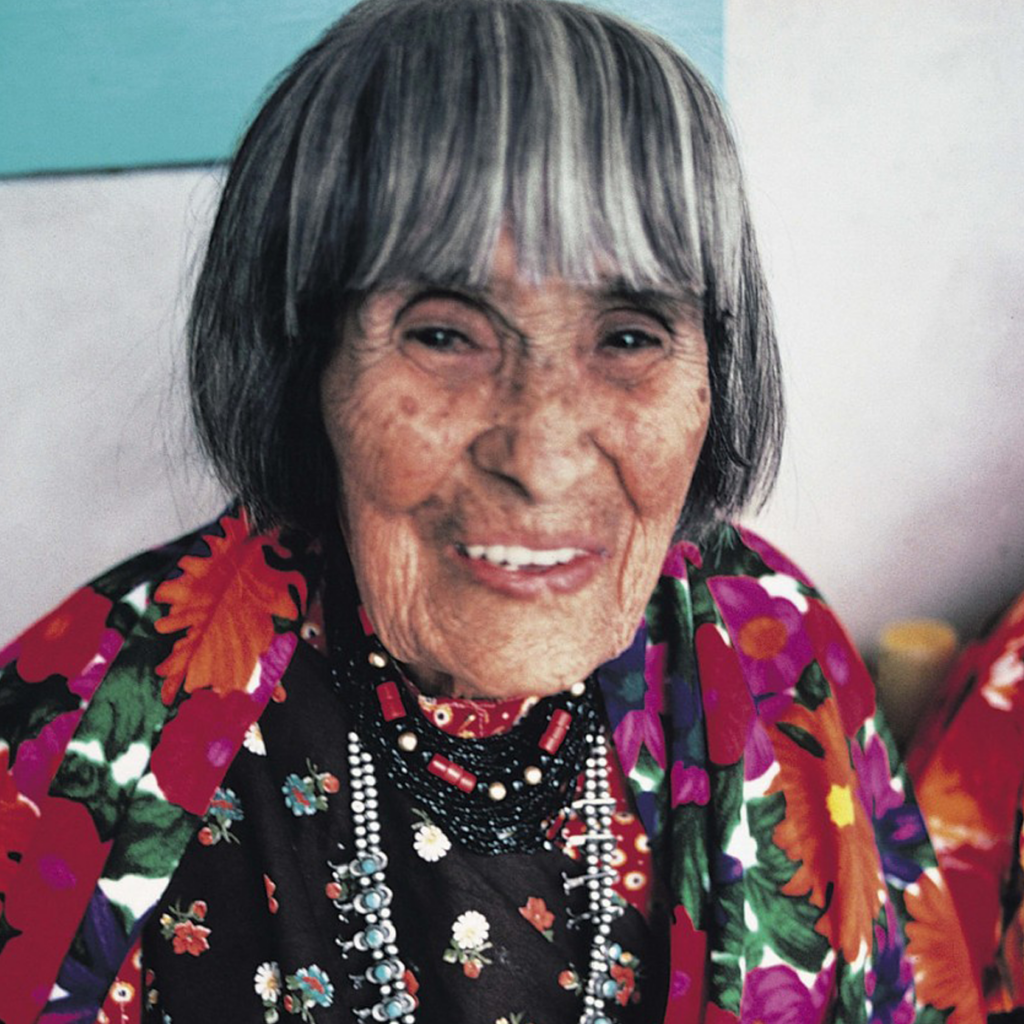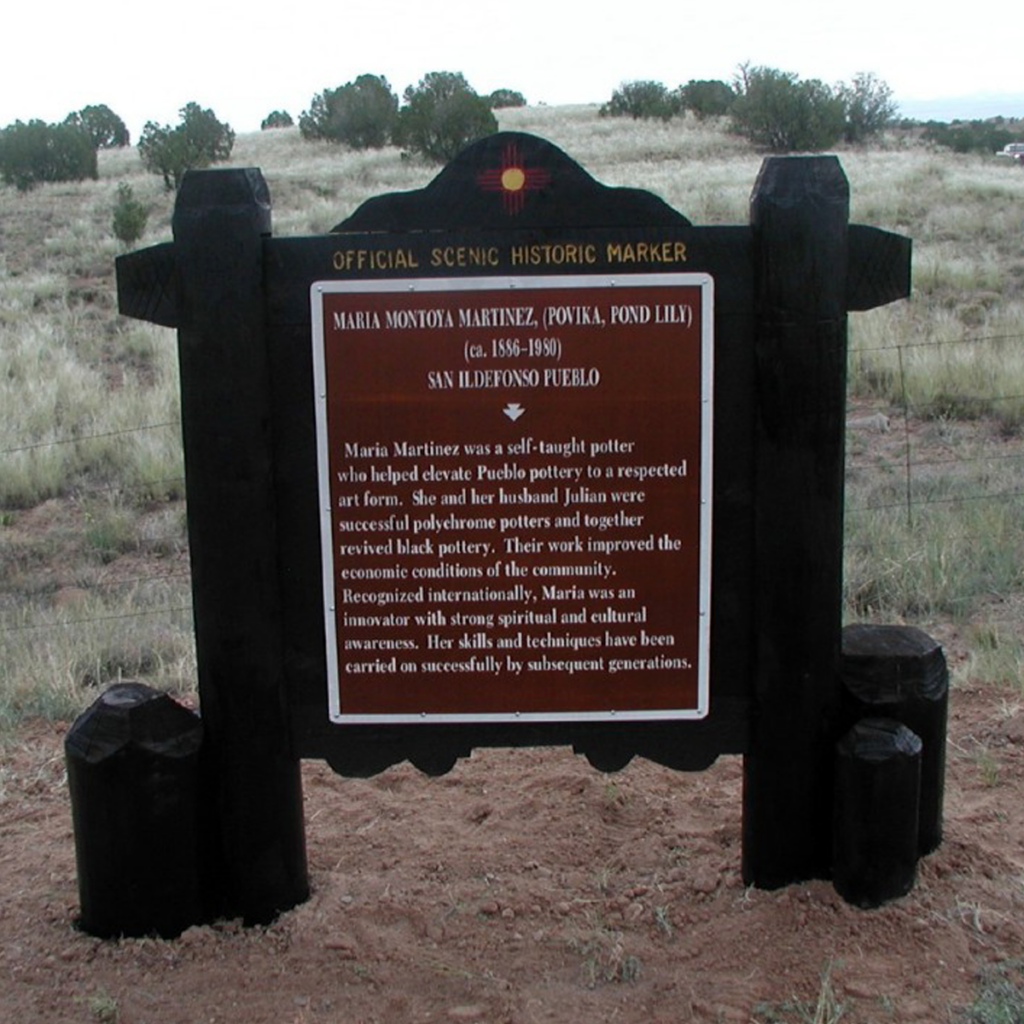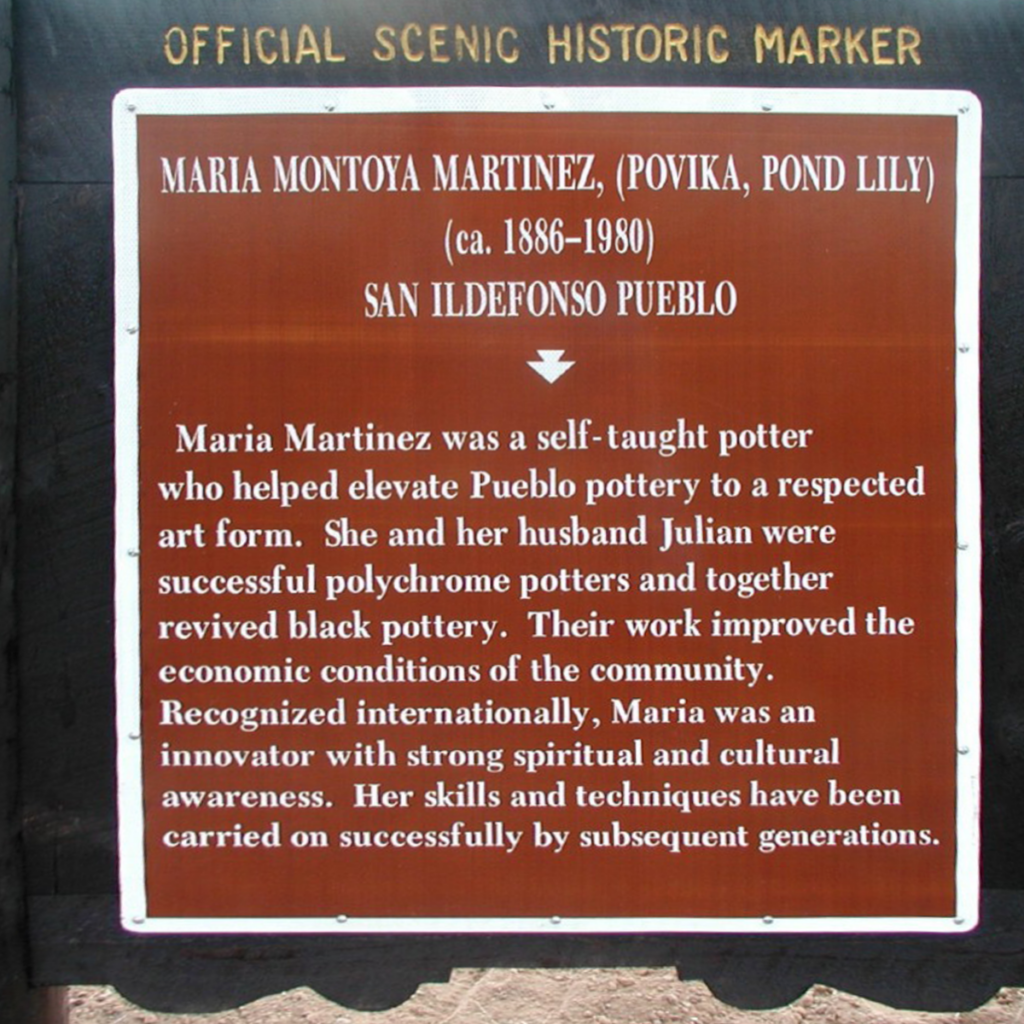Self-taught potter Maria Martinez.
Photo Credit: Courtesy of New Mexico Historic Women Marker Program. Courtesy of New Mexico Historic Women Marker Program.
Maria Montoya Martinez, Povika, “Pond Lily”
1886 - 1980
Santa Fe County
One of the most written about and photographed Pueblo potters, she reinvigorated interest in Pueblo pottery and helped transform a utilitarian item to an art. She and her husband visited the White House and attended world’s fairs, serving as ambassadors of Pueblo life.
Maria Montoya Martinez, Povika, “Pond Lily,” was a self-taught potter, who, with her husband, Julian Martinez, revived black pottery. In the late nineteenth century, pottery usage and production had been in decline as commercially produced goods became more common in New Mexico, a trend that started with the opening of the Santa Fe Trail in 1821. Maria and Julian reinvigorated interest in Pueblo pottery and helped transform the utilitarian item to an art. Maria, who lived into her nineties, was one of the most written about and photographed Pueblo potters.
Maria was born in San Ildefonso Pueblo, a Tewa speaking community about twenty miles northwest of Santa Fe. Born to Tomas and Reycita Peña Montoya, Maria was the second of five daughters. She attended St. Catherine’s Indian School in Santa Fe for two years. As a child, Maria learned to make pottery by observing women in her community, including her maternal aunt, Nicolasa Peña Montoya and Martina Montoya, a respected potter.
In 1904, she married Julian Martinez, also from San Ildefonso. On the same day they married, they headed to St. Louis World’s Fair, where they demonstrated pottery making and traditional dances. In 1907, the School of American Research, under the direction of Dr. Edgar L. Hewett, undertook an excavation of the Pajarito Plateau, a prehistoric Pueblo site. Julian was among the local men hired to dig the site. Maria became interested in pottery shards uncovered at the excavation. Hewett encouraged her to replicate some of the ancient pots, while Julian reproduced wall and pottery designs from the site. Julian, a talented painter, is credited with adapting the avanyu (water or plumed serpent) from ancient sources. As collaborators, Maria shaped the pots and Julian painted them.
Maria and Julian lived and worked at the Museum of New Mexico from 1909 to 1912. Their early pots were polychrome, a style prevalent in San Ildefonso. Around 1912, they began making plain polished black pottery. The pueblos of San Ildefonso, San Juan, and Santa Clara had a long tradition of black pottery. Maria and Julian built on this style, creating a more highly polished finish. By 1919, they developed black-on-black, matte-and-polish pottery, a style that became popular with consumers and was emulated by neighboring Pueblos. Maria was one the first Pueblo potters to regularly sign her work.
Maria received numerous national and international awards and honors, including several honorary degrees. In 1934, she was the first Native American woman to receive a bronze medal for Indian Achievement from the Indian Fire Council, a national organization. Maria attended world’s fairs in St. Louis, San Diego, Chicago, and San Francisco and visited the White House four times. Such notoriety and trips outside of the Pueblo, made Maria, and Julian, ambassadors of their community as they educated non-Indians about Pueblo cultural ways. Maria has also been credited with improving the economic conditions of her community.
Maria and Julian passed on their knowledge of pottery making and traditional ways to their children, and subsequent generations continue to make pottery. After Julian died in 1943, Maria collaborated with her daughter-in-law, Santana, and later with her son, Popovi Da. Maria maintained a traditional Pueblo lifestyle with family and community remaining central in her life. Her legacy as one of the matriarch’s of Pueblo pottery continues.
Sources:
Anderson, Duane, ed. Legacy: Southwest Indian Art at the School of American Research. Santa Fe: School of American Research Press, 1999.
Babcock, Barbara A.
Bright, Brenda Jo and Liza Bakewell. “Marketing Maria.” In Looking High and Low, Tucson: University of Arizona Press, 1995.
Brody, J.J. Pueblo Indian Painting: Tradition and Modernism in New Mexico, 1900–1930. Santa Fe: School of American Research Press, 1997.
Cohen, Lee M. ed. Art of Clay: Timeless Pottery of the Southwest. Santa Fe: Clear Light Publishers, 1993.
Danneberg, Julie. Women Artists of the West: Five Portraits in Creativity and Courage. Golden, CO.: Fulcrum Publishing, 2002.
Dillingham, Rick. Fourteen Families in Pueblo Pottery. Albuquerque: University of
New Mexico Press, 1994.
Eldredge, Charles C. Art in New Mexico, 1900–1945: Paths to Taos and Santa Fe. New York: Abbeville Press, 1986.
Flynn, Kathryn A. Treasures on New Mexico Trails: Discover New Deal Art and
Architecture. Santa Fe: Sunstone Press, 1995.
Gridley, Marion E. “Maria Martinez: Master Artisan.” American Indian Women. New York: Hawthorne Books, 1974, pp. 105–118.
Guthe, Carl E. Pueblo Pottery Making: A Study of the Village of San Ildefonso.
New Haven, CT: Yale University Press, 1925.
Hayes, Allan, and John Blom. Southwestern Pottery: Anasazi to Zuni. Flagstaff, AZ: Northland Publishing, 1996.
Hirschfelder, Arlene B. “Artist and Craftspeople.” Facts on File. New York: 1994.
Hoefer, Jacqueline. A More Abundant Life: New Deal Artists and Public Art in New Mexico. Santa Fe: Sunstone Press, 2003.
Howard, Kathleen, and Diana F. Pardue. Inventing the Southwest: the Fred
Harvey Company and Native American Art. Flagstaff, AZ: Northland Publishing, 1996.
Marriott, Alice Lee, with drawings by Margaret Lefranc. Maria, the Potter of San
Ildefonso. Norman, OK: University of Oklahoma Press, 1948.
McGreevy, Susan Brown. Maria: The Legend, the Legacy. Santa Fe: Sunstone Press, 1982.
Peterson, Susan. Pottery by American Indian Women: The Legacy of Generations. New York: Abbeville Press, 1997.
Peterson, Susan. The Living Tradition of Maria Martinez. Tokyo: Kodansha International, 1977.
Sando, Joe S. Pueblo Profiles: Cultural Identity through Centuries of Change. Santa Fe: Clear Light Publishers, 1998.
Spivey, Richard L. The Legacy of Maria Poveka Martinez. Santa Fe: Museum of New Mexico Press, 2003.
Trimble, Stephen. Talking with the Clay: The Art of Pueblo Pottery. Santa Fe: School of American Research Press, 1993.
Weigle, Marta, and Barbara A. Babcock, eds. The Great Southwest of the Fred Harvey Company and the Santa Railway. Phoenix: The Heard Museum, 1996.
“Maria Laid to Rest at Pueblo.” Albuquerque Journal, July 22, 1980: pp. A1, A7.
Batkin, Jonathan. “Three Great Potters of San Ildefonso and Their Legacy.”
American Indian Art Magazine, 16, 1, pp. 56–69, 85.
Lyon, Dennis. “The Polychrome Plates of Maria and Popovi.” American Indian Art
Magazine, 1, 2, pp. 76–79.
McEvan, Marsha. “Martinez Rekindled a Dying Art.” Santa Fean, September
2000, pp. 51–55, 95.
Spivey, Richard L. “In Memorium.” El Palacio, 86,4, 2000, pp.8–9.
KNME. Notable New Mexicans. Video, Albuquerque: KNME, 2006.
Directions:
Maria Montoya Martinez, Povika, “Pond Lily”
Santa Fe County
Artist | Cultural preservationist |
Statehood (1912 - present) | Territorial Period (1848 - 1912) |
North Central









